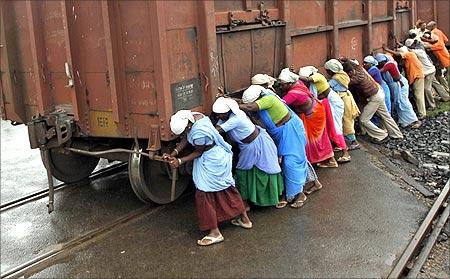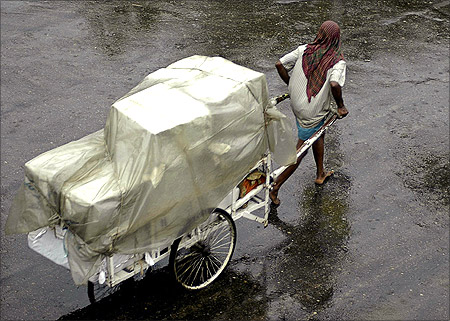Photographs: Reuters Business Standard
As India marks two decades of reform, the year just past, 2011, may well go down as the one year in these decades in which the macro management of India's economy showed the greatest signs of strain.
All the major indicators are in the red. Consider, first, the fiscal deficit.
The Budget declared it would be at 4.6 per cent of gross domestic product (GDP), which was hailed at the time as a sign that the finance ministry wished to strike a blow for fiscal prudence.
Yet it appears, now, that the Budget estimates were a worrying underestimation. It is not just that they did not take into account basic facts like that the 3G auctions, which bailed the fisc out last financial year, would not be an option this year.
. . .
Why India's 2011 macroeconomic numbers are so poor
Photographs: Reuters
It is also that, over the months since the Budget was presented, there appears to have been no reasonable attempt made to control expenditure.
The deficit is likely, thus, to be at least 100 basis points more than the Budgeted level, suggesting, that fiscal responsibility has gone for a complete toss.
The government has shown itself unable to contain its borrowing, which has seen an unprecedented 25 per cent increase over the Budgeted level.
The rupee, meanwhile, saw a steep fall in its value vis-a-vis the US dollar. It was previously overvalued, judging by real effective exchange rate calculations -- but it is nevertheless the case that a 20 per cent depreciation over just four months has delivered serious shocks to the system.
. . .
Why India's 2011 macroeconomic numbers are so poor
Photographs: Reuters
Meanwhile, as global markets slow, it is far from certain that the usual beneficiaries of a weaker rupee -- India's exporters -- will be able to gain.
Imports, however, will become more expensive, thinning corporate margins and making inflation harder to control.
Another headline number that reveals poor macro-economic management is the current account deficit (CAD).
At the time of the 1991 crisis, India's CAD was 3 per cent of GDP. That figure looks modest in comparison to the 3.6 per cent of GDP the economy posted for the first half of the current year.
. . .
Why India's 2011 macroeconomic numbers are so poor
Photographs: Reuters
Slowing export growth as seen in the last couple of months means keeping CAD at last year's level of 2.6 per cent appears difficult this year.
Then, of course, there is inflation, which continues to hover around 9 per cent.
The macro-economic mismanagement these numbers reveal is reflective of poor management all through. The coal sector has been hit hard by political troubles, environmental red tape and land acquisition norms.
Only 9 km of roads are built a day -- as opposed to a target of 20 km. Every kind of major legislation has been on hold: pension reform and the companies Bill.
. . .
Why India's 2011 macroeconomic numbers are so poor
Photographs: Reuters
Even foreign direct investment in multi-brand retail,which did not require Parliament's approval,has been shelved.
In his message for the New Year, Prime Minister Manmohan Singh did underline the need for cutting the deficit, containing the government's subsidies bill and undertaking more reforms.
And if the interest rate falls, then business could see a revival in the second half of the year.
However, given that all reform and sensible policy is still on hold, and sectoral management has shown itself to be poor, there are doubts that the macro-economic indicators will recover over 2012.







article